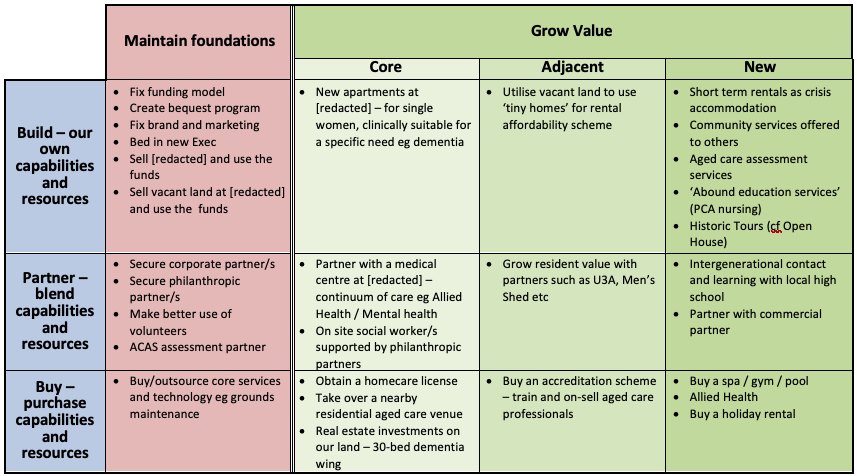Adapting a Growth Model for a Not-For-Profit
Many strategy workshops hold an uncomfortable tension: some participants seek airtime for tough BAU and in-flight projects, and others want to generate and discuss novel ideas. A stand-off between “you don’t understand the immediate issues” and “you can’t think strategically and innovatively” dulls the flow of conversation and the group achieve little beside guzzling ibuprofen.
Early in 2024, I was engaged to support long-term strategy development for Abound Communities, an independent community living organisation. They wanted both stability and change after significant moves in Board and Executive, and their organisational strategy had not been reviewed for many years despite significant developments in the external environment.
My brief included
Building relationships and constructive dialogue among residents, Board and staff
Visioning possible futures
Balancing immediate needs (for example, compliance with changing legislation) and growth
Enabling prioritisation and decision-making
I ran a number of resident workshops, using three potential scenarios as ‘prompts’, and met with each Executive 1:1. Then from the outputs of these, I designed a Board strategy day. I needed a framing tool to support the discussion, and found Vibrance’s recently published Growth Map through my involvement with the Catalyst Network.
I made two adaptations. The first was to be explicit for my NFP audience that ‘growth’ referred to Value and not to Profit. NFP stakeholders can be rightly sensitive about words and concepts that feel too close to for-profit activity, and I wanted to ensure there were no adverse reactions to the language used. This also encouraged broader thinking - an idea might be about serving clients better for the same cost, rather than growing income. The second adaptation was in recognition that continue to exist is always a challenge for all but the largest NFPs, and so needed to be a category of strategic response.
Here is the blank tool I presented to the participants:
Knowing that it would need some unpacking to be a useful tool, I also populated it with twelve made-up future actions from my days as a museum professional. How might a museum in Melbourne apply this model to growing value?
This is superficial, but it helped in a couple of ways: it made the model real, and it prompted a discussion about the different categories. You can argue that some of these are in the wrong box, but in the room we agreed that it didn’t matter. It works as a springboard for ideas.
After talking through the model and taking questions, I created four groups. Each picked one box and got to work. After about fifteen minutes, they reported back and picked another. Three rounds later, we’d got this:
This is unedited. As with all idea-generation sessions, there’s some variance in quality and feasibility. But whether they are all superb ideas isn’t really the issue; there is material to build on in future.
The most helpful outcomes were immediate:
Everyone in the room developed their understanding of each other and so laid the fundamentals of a shared culture. A practical task done together, in a realm of slight uncertainty, builds teams better than so-called ‘teambuilding activities’
Everyone developed an understanding together that for this organisation, addressing some foundational needs was more urgent than value growth
Discussion on next steps solidified into two clear decisions, agreed upon by the Board and Executive together at the end of the day:
Year 1 should focus all the effort of the Executive, and most of the effort of the Directors, on foundational activities
That Year 2 and onwards should begin to focus on value growth, which would be kick-started by some effort from the Directors in Year 1.
Reflections
I opened this newsletter describing the stand-off between participants seeking airtime for current activities, while others want to generate and discuss novel ideas. Because the tool accommodates both ends of this spectrum, and the workflow of tackling one at a time gives mutual comfort to those from each perspective, this tension dissipates. It also allows people to roam a little across the immediate and the long-term, the complex and the simple, the obvious and the radical.
While Vibrance use this model as one part of a structured process for developing a growth strategy, I used it as a tool for supporting conversations within a group that hadn’t spent much time together and needed alignment to each other and to the future.
It removed departmental or historical context from the discussion. We did not go in sequence around Jack and Jill’s departments, nor progress by the order that projects appear in the General Ledger (I’ve seen this done!). This was useful in levelling out the organisational knowledge (it was one Executive’s fourth day in the organisation) and removing hierarchy. I think it also contributed to many of the identified opportunities being wholistic and not departmental.
The client was happy with the outcome and the decisions it enabled. In some ways I would have liked to have spent some time working up a few of these ideas with the group, but it was important that they took this step together and consolidated, rather than being pushed too fast.
Regular readers will know I am highly resistant to ‘Best Practice’ – the idea that organisational success springs from the rigid application of pre-determined tools. A customised tool for a specific circumstance and client need is always better for two reasons. First, context is critical; a tool made for here will always be better than a tool transplanted from there. But secondly, there is a creative energy that springs from facilitator and group working together on something new. It feels very different from being the 37th group that a facilitator has taken through some dog-eared template.
Fin
This will be my last newsletter before the southern-hemisphere summer break. I hope you have a great break, whether it’s sunny beaches or cosy log fires. See you in January.
Paul




